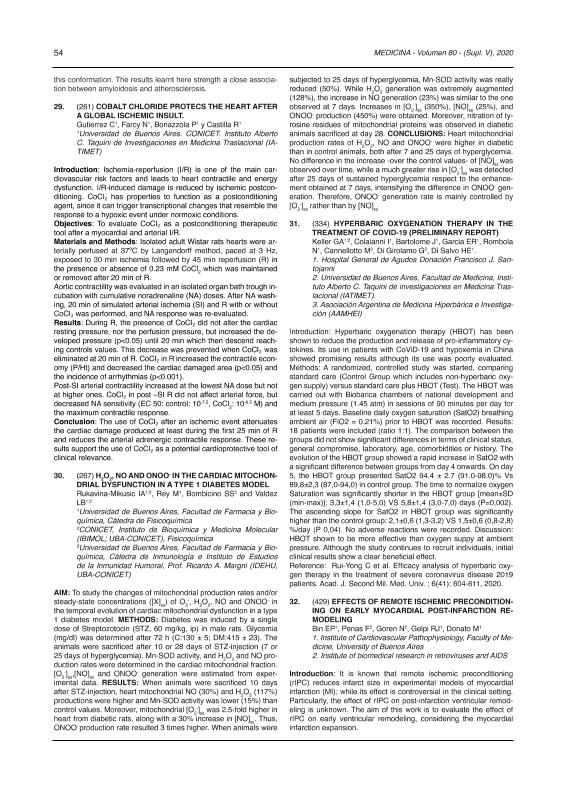Evento
Cobalt chloride protects the heart after a global ischemic insult
Tipo del evento:
Reunión
Nombre del evento:
LXV Reunión Anual de la Sociedad Argentina de Investigación Clínica; LXVIII Reunión Anual de la Sociedad Argentina de Inmunología y Reunión Anual de la Sociedad Argentina de Fisiología
Fecha del evento:
10/11/2020
Institución Organizadora:
Sociedad Argentina de Investigación Clínica;
Sociedad Argentina de Inmunología;
Sociedad Argentina de Fisiología;
Título de la revista:
Medicina (Buenos Aires)
Editorial:
Fundación Revista Medicina
Idioma:
Inglés
Clasificación temática:
Resumen
Introduction: Ischemia-reperfusion (I/R) is one of the main cardiovascular risk factors and leads to heart contractile and energy dysfunction. I/R-induced damage is reduced by ischemic postconditioning. CoCl₂ has properties to function as a postconditioning agent, since it can trigger transcriptional changes that resemble the response to a hypoxic event under normoxic conditions.Objectives: To evaluate CoCl₂ as a postconditioning therapeutic tool after a myocardial and arterial I/R.Materials and Methods: Isolated adult Wistar rats hearts were arterially perfused at 37ºC by Langendorff method, paced at 3 Hz, exposed to 30 min ischemia followed by 45 min reperfusion (R) in the presence or absence of 0.23 mM CoCl2 which was maintained or removed after 20 min of R.Aortic contractility was evaluated in an isolated organ bath trough incubation with cumulative noradrenaline (NA) doses. After NA washing, 20 min of simulated arterial ischemia (SI) and R with or without CoCl₂ was performed, and NA response was re-evaluated.Results: During R, the presence of CoCl₂ did not alter the cardiac resting pressure, nor the perfusion pressure, but increased the developed pressure (p<0.05) until 20 min which then descend reaching controls values. This decrease was prevented when CoCl₂ was eliminated at 20 min of R. CoCl₂ in R increased the contractile economy (P/Ht) and decreased the cardiac damaged area (p<0.05) and the incidence of arrhythmias (p<0.001).Post-SI arterial contractility increased at the lowest NA dose but not at higher ones. CoCl₂ in post ?SI R did not affect arterial force, but decreased NA sensitivity (EC 50: control: 10-7.5, CoCl2: 10-6.5 M) and the maximum contractile response.Conclusion: The use of CoCl₂ after an ischemic event attenuates the cardiac damage produced at least during the first 25 min of R and reduces the arterial adrenergic contractile response. These results support the use of CoCl₂ as a potential cardioprotective tool of clinical relevance.
Palabras clave:
POSTCONDICIONAMIENTO
,
CLORURO DE COBALTO
,
CARDIOPROTECCION
Archivos asociados
Licencia
Identificadores
Colecciones
Eventos (IATIMET)
Eventos de INSTITUTO ALBERTO C. TAQUINI DE INVESTIGACIONES EN MEDICINA TRASLACIONAL
Eventos de INSTITUTO ALBERTO C. TAQUINI DE INVESTIGACIONES EN MEDICINA TRASLACIONAL
Citación
Cobalt chloride protects the heart after a global ischemic insult; LXV Reunión Anual de la Sociedad Argentina de Investigación Clínica; LXVIII Reunión Anual de la Sociedad Argentina de Inmunología y Reunión Anual de la Sociedad Argentina de Fisiología; Argentina; 2020; 54-54
Compartir




